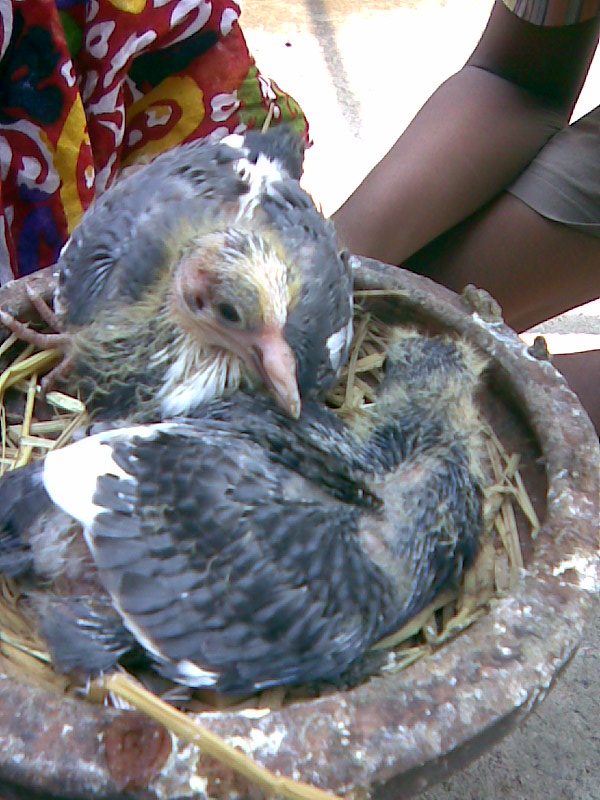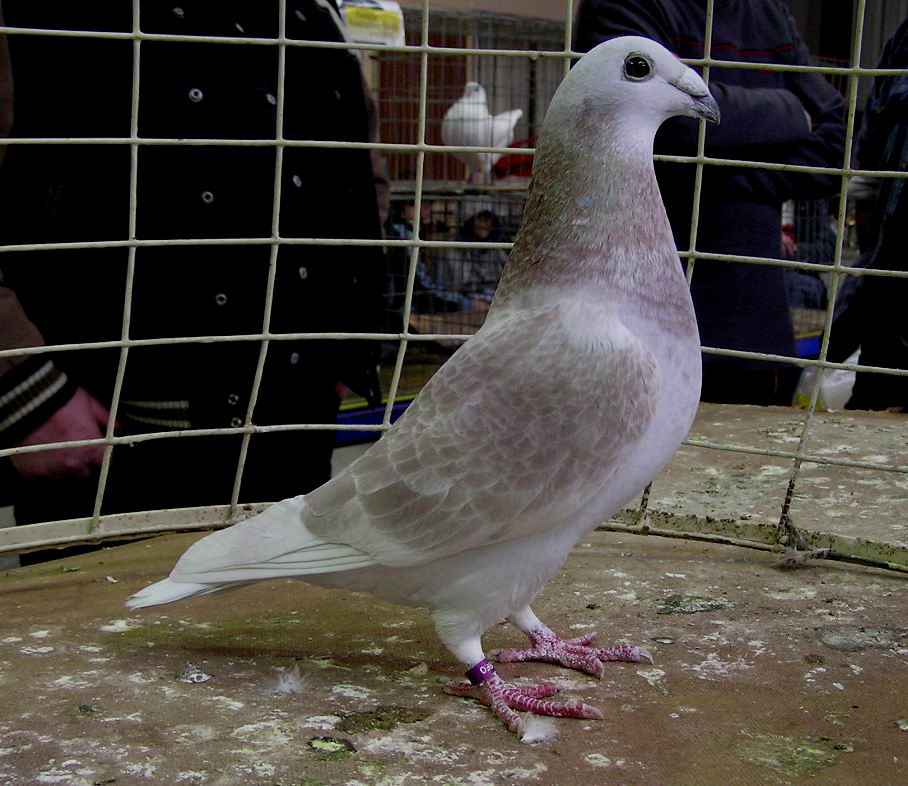|
King Pigeon
The King pigeon is a breed of pigeon developed over many years of selective breeding primarily as a utility breed. Kings along with other varieties of domesticated pigeons are all descendants from the rock pigeon (''Columba livia''). The breed is known for large size and suitability for squab production. Show Kings The breed also has a variety bred for exhibition purposes at pigeon shows. It is called the ''Show King'' to distinguish it from the purely utility variety. The Show King is dual purpose and can be used for squab raising.Seymour, Rev. Colin (Ed)(2006) ''Australian Fancy Pigeons National Book of Standards''. History The King is a dual purpose breed that originated in the United States. They were developed during the 1890s by crossing four older varieties: the Duchess for grace; the Homer for alertness; the Maltese for compactness and style; and the Runt for body and size. Roles with humans Food King pigeon meat is popular in cuisines of parts of China, North Africa, ... [...More Info...] [...Related Items...] OR: [Wikipedia] [Google] [Baidu] |
Breed
A breed is a specific group of domestic animals having homogeneous appearance (phenotype), homogeneous behavior, and/or other characteristics that distinguish it from other organisms of the same species. In literature, there exist several slightly deviating definitions. Breeds are formed through genetic isolation and either natural adaptation to the environment or selective breeding, or a combination of the two. Despite the centrality of the idea of "breeds" to animal husbandry and agriculture, no single, scientifically accepted definition of the term exists. A breed is therefore not an objective or biologically verifiable classification but is instead a term of art amongst groups of breeders who share a consensus around what qualities make some members of a given species members of a nameable subset. Another point of view is that a breed is consistent enough in type to be logically grouped together and when mated within the group produce the same type. When bred together, ind ... [...More Info...] [...Related Items...] OR: [Wikipedia] [Google] [Baidu] |
Domestic Pigeon
The domestic pigeon (''Columba livia domestica'' or ''Columba livia'' ''forma'' ''domestica'') is a pigeon subspecies that was derived from the rock dove (also called the rock pigeon). The rock pigeon is the world's oldest domesticated bird. Mesopotamian cuneiform tablets mention the domestication of pigeons more than 5,000 years ago, as do Egyptian hieroglyphics. Research suggests that domestication of pigeons occurred as early as 10,000 years ago. Pigeons have made contributions of considerable importance to humanity, especially in times of war. In war the homing ability of pigeons has been put to use by making them messengers. So-called war pigeons have carried many vital messages and some have been decorated for their services. Medals such as the Croix de Guerre, awarded to Cher Ami, and the Dickin Medal awarded to the pigeons G.I. Joe and Paddy, amongst 32 others, have been awarded to pigeons for their services in saving human lives. Despite this, city pigeons today are ... [...More Info...] [...Related Items...] OR: [Wikipedia] [Google] [Baidu] |
Selective Breeding
Selective breeding (also called artificial selection) is the process by which humans use animal breeding and plant breeding to selectively develop particular phenotypic traits (characteristics) by choosing which typically animal or plant males and females will sexually reproduce and have offspring together. Domesticated animals are known as breeds, normally bred by a professional breeder, while domesticated plants are known as varieties, cultigens, cultivars, or breeds. Two purebred animals of different breeds produce a crossbreed, and crossbred plants are called hybrids. Flowers, vegetables and fruit-trees may be bred by amateurs and commercial or non-commercial professionals: major crops are usually the provenance of the professionals. In animal breeding, techniques such as inbreeding, linebreeding, and outcrossing are utilized. In plant breeding, similar methods are used. Charles Darwin discussed how selective breeding had been successful in producing change over time in ... [...More Info...] [...Related Items...] OR: [Wikipedia] [Google] [Baidu] |
Utility Pigeon
Utility pigeons are domesticated pigeons bred to be a source of meat called squab. Squabs have been used as a food in many nations for centuries. They were bred to breed and grow quickly.Seymour, Rev. Colin (Ed)(2006) ''Australian Fancy Pigeons National Book of Standards''. Because they are bred for squab production, conformation to a show standard is usually deemed unimportant. Utility pigeons are one of three main breed groupings used by pigeon fanciers. The other two are Flying/Sporting and Fancy. The characteristics of utility pigeons of most importance to the businessperson who is keeping them are rapid growth and high fecundity. There are breeds of pigeons which at one time were raised for utility purposes but which are now raised for show purposes. Fanciers usually distinguish between the two sub-breeds by appending the word "show" or "utility" to the name of the breed. For example, there are show King pigeons and Utility Kings and they are two different breeds of pig ... [...More Info...] [...Related Items...] OR: [Wikipedia] [Google] [Baidu] |
Rock Pigeon
The rock dove, rock pigeon, or common pigeon ( also ; ''Columba livia'') is a member of the bird family Columbidae (doves and pigeons). In common usage, it is often simply referred to as the "pigeon". The domestic pigeon (''Columba livia domestica'', which includes about 1,000 different breeds) descended from this species. Escaped domestic pigeons have increased the populations of feral pigeons around the world. Wild rock doves are pale grey with two black bars on each wing, whereas domestic and feral pigeons vary in colour and pattern. Few differences are seen between males and females. The species is generally monogamous, with two squabs (young) per brood. Both parents care for the young for a time. Habitats include various open and semi-open environments. Cliffs and rock ledges are used for roosting and breeding in the wild. Originally found wild in Europe, North Africa, and western Asia, pigeons have become established in cities around the world. The species is abundant, ... [...More Info...] [...Related Items...] OR: [Wikipedia] [Google] [Baidu] |
Squab (food)
In culinary terminology, squab is an immature domestic pigeon, typically under four weeks old, or its meat. The meat is widely described as tastes like chicken, tasting like dark chicken. The term is probably of Scandinavian origin; the Swedish word ''skvabb'' means "loose, fat flesh". It formerly applied to all Columbidae, dove and pigeon species, such as the Common wood pigeon, wood pigeon, the mourning dove, the extinct-in-the-wild socorro dove, and the now extinct passenger pigeon, and their meat. More recently, squab meat comes almost entirely from domesticated pigeons. The meat of dove and pigeon Galliformes, gamebirds hunted primarily for sport is rarely called squab. The practice of domesticating pigeons as livestock may have come from North Africa; historically, squabs or pigeons have been consumed in many civilizations, including ancient Egypt (still common in modern Egypt), Ancient Rome, Rome, China, India (Northeast), and Middle Ages, medieval Europe. Although squab ha ... [...More Info...] [...Related Items...] OR: [Wikipedia] [Google] [Baidu] |
List Of Pigeon Breeds
This is an alphabetical list of pigeon breeds. Pigeons and doves are members of the bird family Columbidae. Doves tend to be smaller and pigeons larger, although this distinction is not consistently applied. The birds listed here are breeds of the domestic pigeon (''Columba livia domestica''). Other Columbidae species (e.g., the domesticated Barbary dove, ''Streptopelia risoria'') have been developed into breeds, but these are generally simple colour variations. See also List of Columbidae species. A * Aachen Cropper (D/326)Entente Européenne d’ Áviculture et de Cuniculture (2012)''EE-List of the Breeds of Fancy Pigeons'' (ELFP) * Aachen Lacquer Shield Owl pigeon (= Aachen Luster Shield,Encyclopedia of Pigeon Breeds''List of Pigeon Breeds''/ref> ELFP-No. D/705; = Aachen Shield OwlNational Pigeon Association (2014)(table of contents by name)) * Aargae Peak-crested * Abu Abse-Dewlap (D/063) * African Owl pigeon (GB/710) * Agaran Pigeon (RUS(D)/893) * Alpine Swift pigeon * Alsac ... [...More Info...] [...Related Items...] OR: [Wikipedia] [Google] [Baidu] |
Pigeon Breeds
This is an alphabetical list of pigeon breeds. Pigeons and doves are members of the bird family Columbidae. Doves tend to be smaller and pigeons larger, although this distinction is not consistently applied. The birds listed here are breeds of the domestic pigeon (''Columba livia domestica''). Other Columbidae species (e.g., the domesticated Barbary dove, ''Streptopelia risoria'') have been developed into breeds, but these are generally simple colour variations. See also List of Columbidae species. A * Aachen Cropper (D/326)Entente Européenne d’ Áviculture et de Cuniculture (2012)''EE-List of the Breeds of Fancy Pigeons'' (ELFP) * Aachen Lacquer Shield Owl pigeon (= Aachen Luster Shield,Encyclopedia of Pigeon Breeds''List of Pigeon Breeds''/ref> ELFP-No. D/705; = Aachen Shield OwlNational Pigeon Association (2014)(table of contents by name)) * Aargae Peak-crested * Abu Abse-Dewlap (D/063) * African Owl pigeon (GB/710) * Agaran Pigeon (RUS(D)/893) * Alpine Swift pigeon * Alsac ... [...More Info...] [...Related Items...] OR: [Wikipedia] [Google] [Baidu] |







